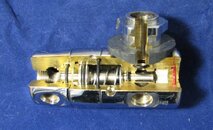I'm sorry, but that is simply not true.Guys, on most regs, the Teflon is against the brass cone, even when not under pressure. There's a spring that holds it against the cone.
Check your diagrams and review how a first stage seals, and it should be obvious that absent tank pressure, both a piston and a diaphragm first stage reg are open, with no contact between the orifice and HP seat.
It is IP that closes the valve.
Yes, when you assemble a regulator, the diaphragm reg has light contact between orifice and valve seat. But only until you apply a bit of spring pressure to the diaphragm. But prior to assembling the top half, that contact pressure is an amount applied only by the small spring behind the poppet. Hardly enough to make an imprint. But that light pressure is why most manufacturers (except Scubapro) recommend assembling the top half (diaphragm and mainspring) first, so that the valve never closes until the guide pin is in place.
The ONLY exception to this is if you assemble the HP side of a diaphragm first stage first, and apply tank pressure with no mainspring in place, in order to check valve seal. Then, you will have contact between poppet and orifice both with and without tank pressure. Once your assemble the rest of the reg, the valve moves to "open", until you turn the tank on.




